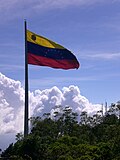Capital Region, Venezuela
 From Wikipedia - Reading time: 5 min
From Wikipedia - Reading time: 5 min

The Capital Region is one of the nine administrative regions in which Venezuela is divided. It includes the states Miranda and Vargas, as well as the Capital District. In 2011, the population of the region was reported to be more than 5 million people.

History
[edit]The region is one of the first eight regions to be created and the presidential decree № 72 of 1969 made its formation official because of this.
In the 1970s, it formed, together with the states of Carabobo and Aragua, the so-called North-Central Coastal Region. In the following decade, after a legal reform, those states were separated to form the Central Region and thus the Capital Region was formed given the geographical location of the city of Caracas, the capital of Venezuela.[citation needed]
Physical aspects
[edit]Relief
[edit]The region is dominated by mountainous forms, belonging to the central section of the Coastal Range.
Climate
[edit]The regional climate is like this:
- Coastal zone; semi-arid tropical climate.
- Windward depression; tropical monsoon climate.
- Caracas Valley; tropical climate of altitude.
- Mountainous zone; tropical climate of altitude.
Hydrography
[edit]The most important river in the region is the Tuy River (239 km), which originates from the Codazzi Peak and the Guaire River
Economy
[edit]Its economy is based on industry and commerce, it has an important port such as La Guaira, which allows commercialization with other countries. This brings as consequence the increase of the population in this region due to the opportunity for the commercialization of products and the offer of jobs.
Despite the fact that the capital of the country is located in this region, a part of the primary sector that has survived is predominant, such as cocoa planting in the areas of Barlovento in the state of Miranda.
The state of Miranda is the area of greatest agricultural activity in the region, highlighting the cultivation of cocoa, sugar cane, poultry and raising cattle and pigs.
It is one of the 9 regions in which Venezuela is divided, has a large economy that allows industries to continue growing and has some very important centers, both financial and industrial.
Gallery
[edit]-
Vargas State Beach
-
Los Teques Miranda State
-
Tacarigua Lagoon National Park
-
Naiguatá, Vargas State
 KSF
KSF



